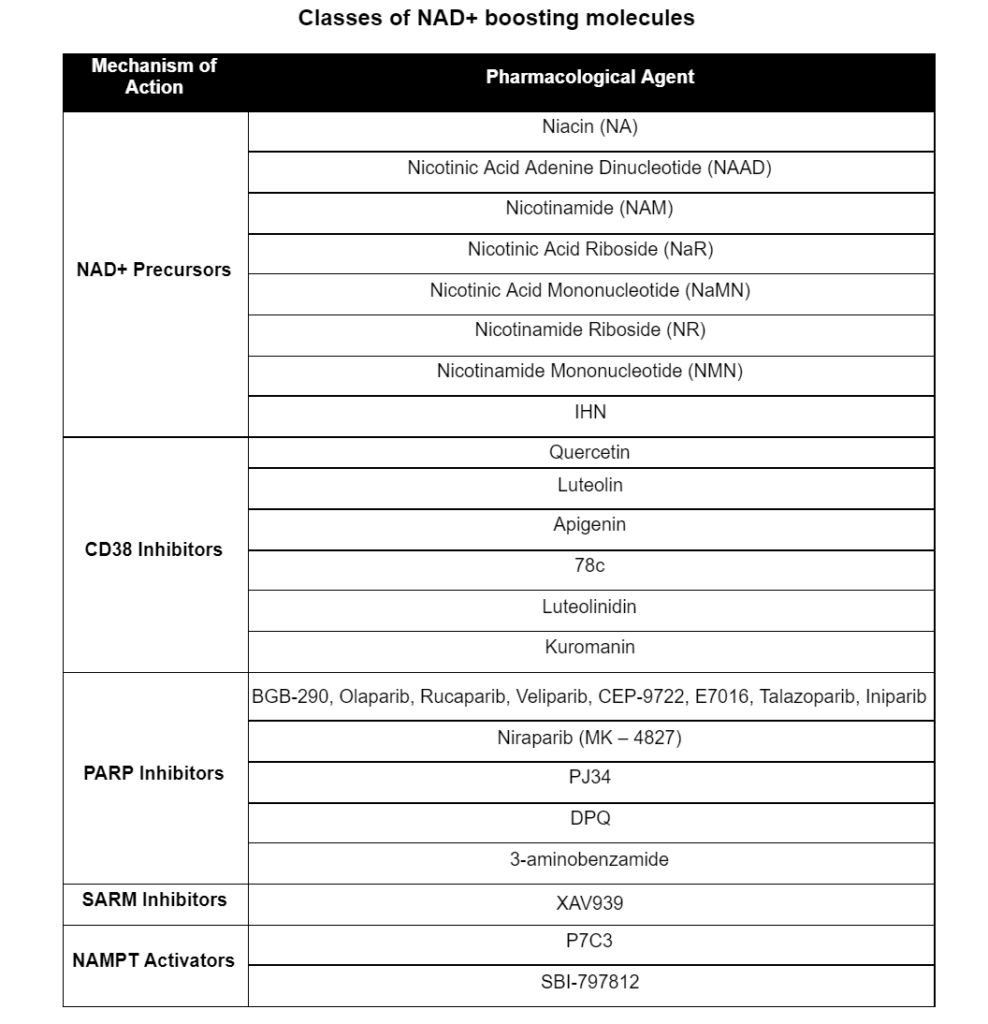NAD+ Boosters and their Potential as Longevity and Health-Promoting Compounds
NAD+ boosting molecules can benefit healthspan and longevity and ameliorate age-related conditions through unique pathways from metabolic precursors to enzymatic regulators.
Researchers have demonstrated the crucial roles of the molecule nicotinamide adenine dinucleotide (NAD+) in health and longevity with laboratory animals like rodents, flies, and roundworms. Examples related to its benefits abound where boosting NAD+ levels improves cognition, metabolic health, and cardiovascular wellbeing in these animals during aging.
This doesn’t seem surprising given that animal and human cells require NAD+ for over 500 enzymatic reactions that regulate nearly all major biological processes. So, the question remains whether boosting NAD+ with different molecules may also help people live healthier and longer lives, and, if so, which compounds are the best suited for particular medical conditions.
NAD+-Boosting Molecules
Molecules that boost NAD+ levels include metabolic precursors that enhance NAD+ biosynthesis and compounds that affect specific enzymes to promote the generation or inhibit degradation of NAD+. Besides their mechanism of action, the key differences between these NAD+ boosters are their unique effects on different tissues. For instance, one booster may increase NAD+ levels primarily in skeletal muscle while another raises its levels in the liver.
So, given the tissue-specific effects of different NAD+ boosters, using them likely provides distinct physiological benefits. To explore more detail about these differences, the following will give a brief comparison of the many NAD+-boosting molecules.

NAD+ Precursors
You can think of NAD+ precursors as the building blocks that cells need to synthesize the crucial bioenergetic NAD+ molecule. These precursors include B3 vitamins like nicotinamide (NAM), niacin (NA), nicotinamide riboside (NR), and nicotinamide mononucleotide (NMN). The molecules take advantage of the NAD+ biosynthesis pathway called the salvage pathway, the most prevalent means of recycling molecular components of and synthesizing NAD+ in cells.
Numerous studies have shown that supplementing with NAD+ precursors NMN or NR can promote health and longevity the best in rodents and potentially humans. Unlike other B3 vitamins like NAM, neither NMN nor NR trigger flushing and nausea, and they don’t inhibit the function of DNA repair and metabolism-promoting proteins, such as poly(ADP-ribose) polymerases (PARPs) and sirtuins.
NMN clinical studies have shown that taking this NAD+ precursor improves insulin sensitivity in aged women, muscle function in older men, and oxygen utilization capacity in runners. An NR study of humans also showed that it, too, may enhance muscle function by improving metabolism and reducing the abundance of inflammatory molecules in the muscles of aged individuals. At the same time, another NR clinical trial showed the precursor didn’t enhance the function of the cell’s powerhouse, the mitochondria, in obese men’s muscles. As clinical trial data accumulates, researchers will continue to ponder which NAD+ precursor, between NMN and NR, is the best for increasing NAD+ and enhancing life and healthspans.
NAD+ Synthesis Activators
An alternative way to trigger an upsurge in NAD+ is to activate NAD+ biosynthetic enzymes directly. One such protein that limits the enzymatic rate for NAM to NAD+ conversion is NAMPT. Since NAMPT levels decline with age, figuring out how to activate its synthesis and activation has become a hot topic in the anti-aging field. So far, a couple of NAMPT activators have been identified. One is known as P7C3, which has shown neuroprotective effects, and another is called SBI-797812, which was shown to boost NAD+ levels in several mouse organs.
Another NAD+ synthesis molecule with potential benefits upon stimulation is nicotinamide mononucleotide adenylyltransferase (NMNAT). An example of a molecule that activates it is the green tea compound epigallocatechin gallate (EGCG).
Inhibitors of NAD+ Degradation
Inhibiting NAD+ degradation is yet another approach to raise NAD+ levels in cells. The enzyme CD38 that functions by activating immune cells called T cells to produce inflammatory molecules (cytokines) likely is the most significant source of NAD+ consumption. To inhibit its capacity to consume NAD+, researchers use CD38 inhibitors like apigenin and 78c that have been shown to ameliorate metabolic disorders and possibly other age-related diseases. Similarly, luteolinidin inhibits CD38 to prevent heart dysfunction after a blood supply restriction – ischemia.
NAD+ degradation inhibitors that suppress the activity of enzymes called poly(ADP-ribose) polymerase (PARP) constitute another way to boost NAD+ levels. PARPs use NAD+ to perform their function of repairing DNA damage. As we age and DNA damage accumulates, PARPs go into overdrive, sucking up lots of NAD+. So, using one of the many PARP inhibitors like Olaparib presents a means to substantially increase NAD+ levels and preserve the NAD+-related reactions necessary for health and longevity.
The three classes of NAD+ boosters that include precursors, molecules that activate NAD+ synthesis, and compounds that inhibit NAD+ degradation might play significant roles in improving health and extending lifespan. Clinical trials continue that will show whether the positive findings in animals apply to humans.
NAD+ Boosters in Clinical Trials
Along those lines, the most studied of the NAD+ precursors in clinical trials is niacin, which improves blood cholesterol levels when consumed in doses greater than a gram. Moreover, nicotinamide and niacin are being evaluated as treatments for acne, kidney diseases, Alzheimer’s disease, schizophrenia, diabetes, lung cancer, obesity, liver diseases, and others. If niacin and nicotinamide turn out to combat these ailments, future research can then examine whether NMN and NR enhance such benefits.
Since these NAD+ boosters confer unique advantages for specific diseases, taking them in tandem could be an avenue for future experimentation and clinical trials. Figuring out which ones to take or whether to use them synergistically could present an exciting new way to combat age-related illnesses.
Though there is much to learn, the future looks bright for NAD+-boosting molecules since evidence continues to compile showing their longevity and health-boosting benefits. Whether their effects come from precursors, molecules that activate NAD+-related pathways, or inhibiting NAD+ consuming proteins, it is an impressive concept to imagine these NAD+ boosters being not only tested to enhance health, reduce disease, and extend lifespan in people, but succeeding.

